Paul Gannon Paipo Interview
March 14, 2011. Coopers Shoot (NSW), Australia
E-mail interview and questions by Bob Green
Photos courtesy of Paul Gannon, Gary Clist
Little Avalon was a favorite spot for bodysurfers and bellyboard
riders. Paul was one of a group who surfed Little Avalon before
traveling around Australia. He started on ply boards made by Robert
Hosking and after many years on other surfcraft has recently begun
riding one of Dick Ash's new bellybogger models.
|
1. How did you first get into
riding a bellyboard? When and where was this?
I guess it was an
easy transition from surf mats (surfoplanes) when I was in Primary
school. I used to ride at Cronulla when in primary school and then we
moved to Avalon as I began sixth class (1959). We used to watch the
guys from Maroubra body surf little Avalon in the early 1960s, and
wished we were game to do that. A guy named Peter Sobels in Avalon surf
club then made a bellyboard based on a paipo design that he saw in
Hawaii. He was older than us but it didn't take too long before we
attempted replications. Robert Hosking led the way and he began to make
boards from marine ply similar to Peter Sobel's designs. The first
board Robert made was a single fin (see Robert holding his first board
many, many years later with the fin removed in the included photos…..
he subsequently used it as a skidboard). Robert became the principal
designer and manufacturer of nearly all the bellyboards made in Avalon
during the 1960s.
Paul
at Whale Beach, circa 1970
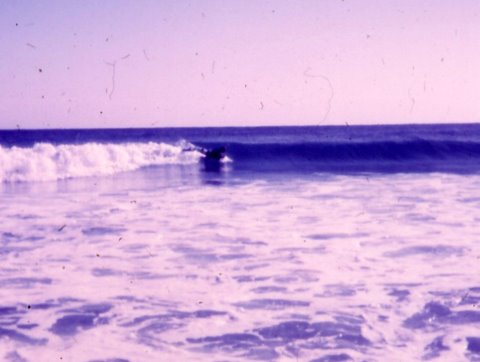
Photo
courtesy of Paul Gannon.
2. Were there other bellyboard
riders around at the time?
I surfed a lot at
Little Avalon with my mate, Jim Murdoch, who was and remained a body
surfer. Robert Hoskings came out of course but Dave Flatt and I were
the main bellyboard riders with others like John Bridger, Donald
"Ducksie" O'Brien and Malcom Robertson riding belly boards at the time.
3. Who made your first board?
What was it like?
Robert Hosking made
my first two belly boards. The first one was like his first with a
single fin. It didn't handle Little Avalon's tube too well so Robert
advanced his designs to twin fins.
Paul's
second board on top of Dave Cairn's GT Cortina packed for a trip to
Noosa, ca. 1970.
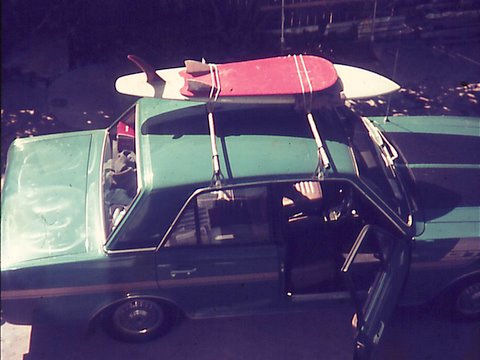
Photo
courtesy of Paul Gannon.
4. How did you meet up with
Robert Hosking? Did Robert make and ride bellyboards? What were his
boards like?
There was a large
group of us at Avalon who went to Narrabeen Boy's High School which was
the closest High School at the time. Robert was a Cranbrook Boy and had
to travel to the other side of Sydney to go to school so it was a
credit to his sociability that he was able to gain access to our
tightly knit group. He was an electronics nut and so was "Ducksie" so
the two of them made contact on that, which progressed into surfing, as
Robert became part of our group.
5. Where did he make his
boards? Do you know how many he made and if their was much variation in
the boards he made?
Robert was innovative
with a quick and inventive mind. He was the least like a surfer in
looks (and ability) but his agile brain turned successfully to many
things. He later became an architect! His boards developed away from
single fin paipos to a shape of his own that was very successful at
Little Avalon. He made all of his boards in a small shed in the
backyard of his parent's home in Avalon Parade. Initially they were
varnished, with later boards coated with resin of different colors.
His twin fins were angled and turned outwards, pretty much how twin
fins have turned out on surfboards of today! Robert also made some
delta shaped boards that went very well also.
Robert
Hosking in 1998, with a finless board from ca. 1963.
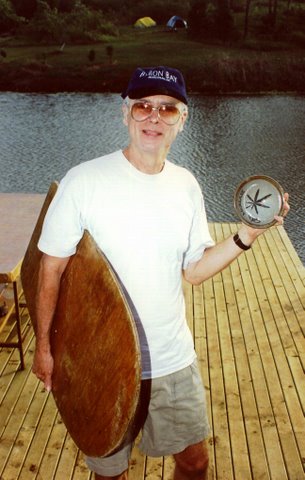
Photo
courtesy of Paul Gannon.
6. You mentioned going to
Narrabeen High and that the school was full of surfers. What was it
like going to school there? I gather you wouldn't even make it to
school some days?
Narrabeen Boy's High
school was a buzzing hive of surfers. Kids attended all the way from
Dee Why in the south to Palm Beach in the north. Going from Avalon to
and from school in the bus we passed six beaches, all of them with good
surfing breaks. We knew by the time we got home from school what the
surf would be like at Avalon from our glimpses of all of the other
breaks. We often missed the school bus in the morning because we were
out at Little Avalon and had to hitch to school. Many times we "knicked
off" from school to surf North Narrabeen during the school day. We
always made it back to school in time to catch the school bus home.
It was the same with many
others at school……. all with their minds on surfing. Nat Young went to
Narrabeen at the time, as did Mark Warren and Ian Cairns. There were
many others too numerous to mention.
Paul,
Robert Hosking and Dave Cairns, 1998.
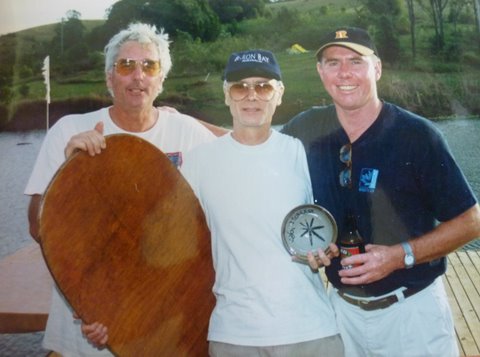
Photo
courtesy Paul Gannon.
7. How were bellyboarders
viewed in those days? Did you have friends who rode bellyboards?
Bellyboarders around
the peninsula at the beginning of the 1960s were the ones pushing the
limits of surfing. The longboards caught waves that were more rolling
than steep. If you fell off your board it most often went all the way
in, maybe hitting a few other boards along the way! There were no leg
ropes! Board riders weren't (and still aren't) good swimmers in the
main. They paddled boards well, but didn't like a long swim after their
boards. They weren't that adventurous in catching waves that they might
get wiped off and the boards they rode weren't capable of easily riding
steep tubing waves. Belly boards were KINGS of the steep hollow wave.
Little Avalon was and is, on its day, one of the best steep and hollow
waves around. Bellyboards and bodysurfers dominated Little Avalon then.
If a board rider wiped out at Little Avalon their board was lost on the
rocks! This was an inevitability in the days before leg ropes and light
short surfboards. The only board rider that consistently rode Little
Avalon with us was "Midget" Farrelly. He "never" fell off and he was a
gentleman surfer who shared the surf.
In retrospect our
bellyboards were the precursors of the modern short board with twin
fins. Our bellyboards were there with the design innovations long
before boardriders adopted them, i.e., shortness and twin fins. We were
riding the steep and "locked in" part of the wave long before they
could and they only could after they adopted our design features AND
adopted LEGROPES!!! Bellyboard riders were always being ridden over and
dropped in on by board riders. We were disadvantaged in the speed that
we could move (paddle) through the water, our board size, and the fact
that we nearly always took off inside the point where most boardies
would. Of course, we were always outnumbered by the number of board
riders in the surf EXCEPT at Little AVALON!
One final point about those
days was the ability of some bellyboarders to ride on their knees. This
enabled the rider to travel faster across the wave without leg drag.
Those of us that could ride on the belly or the knee got the best of a
Little Avalon wave. We were doing all of this BEFORE we had even heard
of George Greenough or McTavish who have been acknowledged as the
innovators of the "shortboard!"
8. Do you recall Dick Ash
surfing his bellyboards? When was this?
I do recall Dick Ash
riding Little Avalon. It had to be around the mid-1960s. Like Peter
Sobels, he was older than the rest of us and the relationship was little
more than small talk in the surf.
9. You've mentioned Midget
Farrelly also surfing there. Why just Midget and when did Little Avalon
change from a bodysurfing/paipo spot to a stand-up surfing spot?
Leg ropes,
shortboards, and an aggro selfish attitude of the boardriders at the
time marked the demise of bellyboarders at Little Avalon.
Aden Parsons at
Little Avalon May 9, 1964, without the crowd.
|
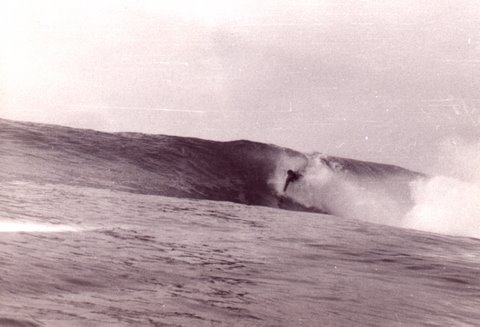
|
|
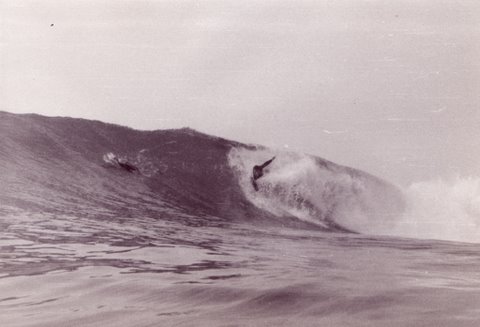
|
Photo
by Dennis Markson.
10. Where else besides Avalon
did you ride your bellyboard? In your travels did you come across other
bellyboards?
During the second
half of the 1960s, I rode my board from Noosa through to the Sydney
northern beaches, at Cactus on the Nullabour and to Margaret River, Western Australia (W.A.).
Very rarely did I come across other bellyboards. I remember riding with
two local bellyboarders at Yallingup in W.A.
11. What was the attraction of
a bellyboard for you?
As a teenager with
little money, cost was appealing. Most certainly the ability, like the
"Enterprise," to go where no man had gone before! As mentioned earlier,
surfers on boards were not at the time riding the hollow part of the
wave. Nor were they surfing spots off rocks like Little Avalon. On
a bellyboard, it didn't matter where you were, you could get a wave
away from the crowds!
12. Any waves or surfs on
these paipo boards still stand out for you?
A day at Noosa,
February 1969, on my little orange board taking off inside of everyone
on boards and making 10-foot waves they could not! My first waves at
Angourie in February 1969. Crescent Head, 1967! Every day at Little
Avalon!
13. How long did you ride a
bellyboard for? When did you start riding kneeboards? Any similarities
between these surfcraft?
My bellyboards all
became my kneeboards! They were both at the same time. I started riding
them in my early teens in the early 1960s, and stopped by my early
20s. University, work, and the usual took over.
Copy of a
Hosking board made by Gary Clist. 48 inches long, it differs from the original
by having the sides rounded and concave in the bottom. Paul estimates
his board was about 38 to 40 inches long.
|
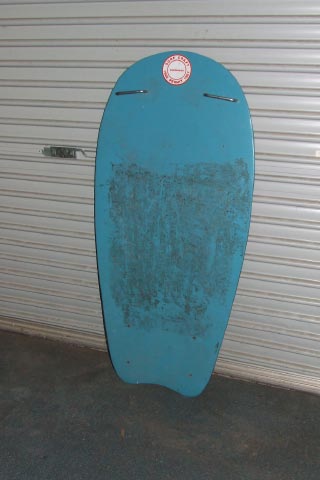
|
|
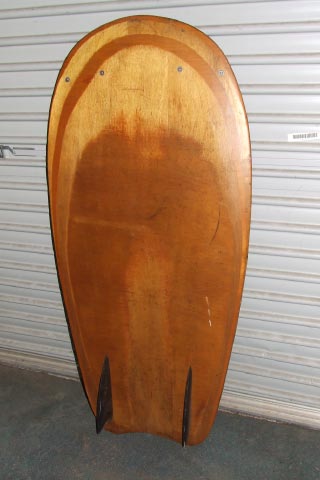
|
Photo
courtesy Gary Clist.
14. I believe you have
recently tried one of Dick Ash's new boards. How did this board ride?
How does this board compare to the older ply boards?
It was a "deja vu"
moment to try one of Dick Ash's new boards… took me right back to my
teens! After 42 years since, and having spent time with surf kayaks,
windsurfers, and long boards, its hard to believe that the same "good
fun" feeling comes right back… not to mention how my ankles, knees, and
hips feel… so good! Thanks Dick. The board I have just bought from you
is magic!
Paul
with the latest bellybogger.
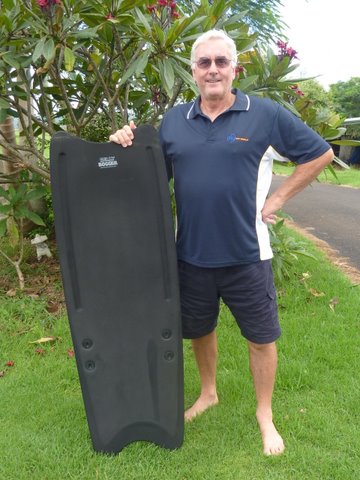
Photo
courtesy Paul Gannon
|
I am aware that some of the images and other content on this website may be subject to copyright and
will gladly remove any such items if so requested by the genuine holder
of the rights. Such content is not used for commercial exploitation. The sole purpose is to share knowledge with enthusiasts and interested parties. To the extent possible copyright holders have been contacted for permission to share content on this website. Likewise please respect the copyright content of this site.
|
All
contents of this site ©1998-2025 Rod's Home Port
for SurfMarks and MyPaipoBoards.
All
images within this section copyright of
respective
credited contributor.
|
|
Last updated
on: 02/10/14
|